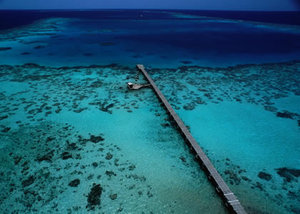Red Sea
|
|

The Red Sea (Arabic البحر الأحمر Baḥr al-Aḥmar, al-Baḥru l-’Aḥmar; Hebrew ים סוף Yam Suf; Tigrigna ቀይሕ ባሕሪ QeyH baHri) is a gulf or basin of the Indian Ocean between Africa and Asia. The connection to the ocean is in the south through the Bab el Mandeb sound and the Gulf of Aden. In the north is the Sinai Peninsula, the Gulf of Aqaba and the Gulf of Suez (leading to the Suez Canal). The sea is roughly 1900 km long and at its widest is over 300 km. The sea floor has a maximum depth of 2,500 m in the central median trench and an average depth of 500 m, but it also has extensive shallow shelves, noted for their marine life and corals. The sea has a surface area of roughly 438,000 or 450,000 km². The sea is the habitat of over 1000 invertebrate species and 200 soft and hard corals. The sea occupies a part of the Great Rift Valley.
| Contents |
Name
The sea was called the "Arabian Gulf" in most European sources up to the 20th century. This was derived from older Greek sources. Herodotus, Straban and Ptolemy all call the waterway "Arabicus Sinus", while reserving the term "Sea of Erythrias" (Red Sea) for the waters around the southern Arabian Peninsula, now known as Indian Ocean.
The name of the sea does not indicate a real red colour, as the seawater is actually blue when viewed afar, and transparent when held in hand. It may signify the seasonal blooms of the red-coloured cyanobacteria Trichodesmium erythraeum near the water surface. Some suggest that it refers to the mineral-rich red mountains nearby, which are indeed called "הרי אדום" ("Mounts of the Edomites" or "the Rubi mountains") in Hebrew language. There is also speculation that the name Red Sea came from a mistranslation of what should have been the Reed Sea.
Physical Properties
Surface water temperatures remain relatively constant at 21-25°C and temperature and visibility remain good to around 200 m, but the sea is known for its strong winds and tricky local currents. The sea was created by the division of Africa from the Arabian peninsula, a movement which began around 30 million years ago. The sea is still widening and there are small volcanic features in the deeper parts, it is considered that the sea will become an ocean in time (as proposed in the model of Tuzo Wilson).
Tourism
The sea is known for its spectacular dive sites such as Ras Mohammed, Elphinstone, The Brothers and Rocky Island in Egypt, and less known sites in Sudan such as Sanganeb, Abington, Angarosh and Shaab Rumi (see photo above).
The Red Sea was "discovered" as a diving destination by Hans Hass in the 1950s, and by Jacques-Yves Cousteau later.
Bordering Countries
Bordering countries are:
- Northern shore:
- Western shore:
- Sudan
- Egypt
- Eastern shore:
- Southern shore:
Towns and Cities
Towns and cities on the Red Sea coast include: Assab, Massawa, Hala'ib, Port Sudan, Port Safaga, Hurghada, El Suweis, Sharm el Sheikh, Eilat, Aqaba, Dahab, Jedda, Al Hudaydah.
See also
ca:Mar Roja da:Røde Hav de:Rotes Meer et:Punane meri es:Mar Rojo eo:Ruĝa Maro fr:Mer Rouge he:ים סוף nl:Rode Zee ja:紅海 no:Rødehavet pl:Morze Czerwone pt:Mar Vermelho (mar) ru:Красное море sv:Röda havet zh:红海

